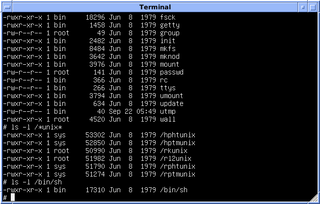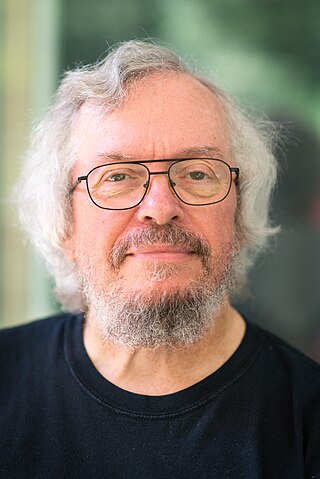Related Research Articles

Bash, short for Bourne-Again SHell, is a shell program and command language supported by the Free Software Foundation and first developed for the GNU Project by Brian Fox. Designed as a 100% free software alternative for the Bourne shell, it was initially released in 1989. Its moniker is a play on words, referencing both its predecessor, the Bourne shell, and the concept of renewal.

KornShell (ksh) is a Unix shell which was developed by David Korn at Bell Labs in the early 1980s and announced at USENIX on July 14, 1983. The initial development was based on Bourne shell source code. Other early contributors were Bell Labs developers Mike Veach and Pat Sullivan, who wrote the Emacs and vi-style line editing modes' code, respectively. KornShell is backward-compatible with the Bourne shell and includes many features of the C shell, inspired by the requests of Bell Labs users.

A Unix shell is a command-line interpreter or shell that provides a command line user interface for Unix-like operating systems. The shell is both an interactive command language and a scripting language, and is used by the operating system to control the execution of the system using shell scripts.

The Bourne shell (sh) is a shell command-line interpreter for computer operating systems.

The Z shell (Zsh) is a Unix shell that can be used as an interactive login shell and as a command interpreter for shell scripting. Zsh is an extended Bourne shell with many improvements, including some features of Bash, ksh, and tcsh.
C News is a news server package, written by Geoff Collyer, assisted by Henry Spencer, at the University of Toronto as a replacement for B News. It was presented at the Winter 1987 USENIX conference in Washington, D.C.

Henry Spencer is a Canadian computer programmer and space enthusiast. He wrote "regex", a widely used software library for regular expressions, and co-wrote C News, a Usenet server program. He also wrote The Ten Commandments for C Programmers. He is coauthor, with David Lawrence, of the book Managing Usenet. While working at the University of Toronto he ran the first active Usenet site outside the U.S., starting in 1981. His records from that period were eventually acquired by Google to provide an archive of Usenet in the 1980s.
Media Player Classic (MPC), Media Player Classic - Home Cinema (MPC-HC), and Media Player Classic - Black Edition (MPC-BE) are a family of free and open-source, compact, lightweight, and customizable media players for 32-bit and 64-bit Microsoft Windows. The original MPC, along with the MPC-HC fork, mimic the simplistic look and feel of Windows Media Player 6.4, but provide most options and features available in modern media players. Variations of the original MPC and its forks are standard media players in the K-Lite Codec Pack and the Combined Community Codec Pack.

Catalina Sky Survey is an astronomical survey to discover comets and asteroids. It is conducted at the Steward Observatory's Catalina Station, located near Tucson, Arizona, in the United States.

Henry E. Holt was an American astronomer and prolific discoverer of minor planets and comets, who has worked as a planetary geologist at the United States Geological Survey and Northern Arizona University.
William Kwong Yu Yeung is a Hong Kong-born, Canadian amateur astronomer with telescopes based in the United States.

Višnjan Observatory is an astronomical observatory located near the village of Višnjan in Croatia. It is headed by Korado Korlević, a prolific astronomer and discoverer of minor planets. In 2009, the Višnjan observatory moved to Tičan and received the obs. code L01 on 5 October 2017.

Software portability is a design objective for source code to be easily made to run on different platforms. An aid to portability is the generalized abstraction between the application logic and system interfaces. When software with the same functionality is produced for several computing platforms, portability is the key issue for development cost reduction.
1868 Thersites is a large Jupiter trojan from the Greek camp, approximately 70 kilometers in diameter. Discovered during the Palomar–Leiden survey at Palomar in 1960, it was later named after the warrior Thersites from Greek mythology. The presumed carbonaceous C-type asteroid belongs to the 50 largest Jupiter trojans and has a rotation period of 10.48 hours.
3793 Leonteus is a large Jupiter trojan from the Greek camp, approximately 90 kilometers in diameter. It was discovered on 11 October 1985, by American astronomer couple Carolyn and Eugene Shoemaker at the Palomar Observatory in California, United States. The D-type Jovian asteroid belongs to the 30 largest Jupiter trojans and has a rotation period of 5.6 hours. It was named after the hero Leonteus from Greek mythology.
13123 Tyson, provisional designation 1994 KA, is a stony Phocaea asteroid and an asynchronous binary system from the inner regions of the asteroid belt, approximately 10 kilometers in diameter. It was discovered on May 16, 1994, by American astronomer Carolyn Shoemaker and Canadian astronomer David Levy at the Palomar Observatory in California, United States. The asteroid was named for Neil deGrasse Tyson, American astrophysicist and popular science communicator.
Observations of minor planets as well as comets and natural satellites of the Solar System are made by astronomical observatories all over the world and reported to the Minor Planet Center (MPC), a service of the International Astronomical Union. The MPC maintains a data base that stores all observations submitted by these registered observatories. An astrometric record consists of the position, brightness and timestamp of an observed object, besides additional information. The database contains more than 200 million records gathered over the past two centuries.
References
- 1 2 3 "129101 Geoffcollyer (2004 XF6)". Minor Planet Center. Retrieved 12 August 2019.
- ↑ Mark Linimon (1994). C News Frequently Asked Questions .
- ↑ C News source code
- ↑ http://schilytools.sourceforge.net/bosh.html Archived 2019-09-27 at the Wayback Machine Bourne Shell project page
- ↑ "MPC/MPO/MPS Archive". Minor Planet Center. Retrieved 12 August 2019.